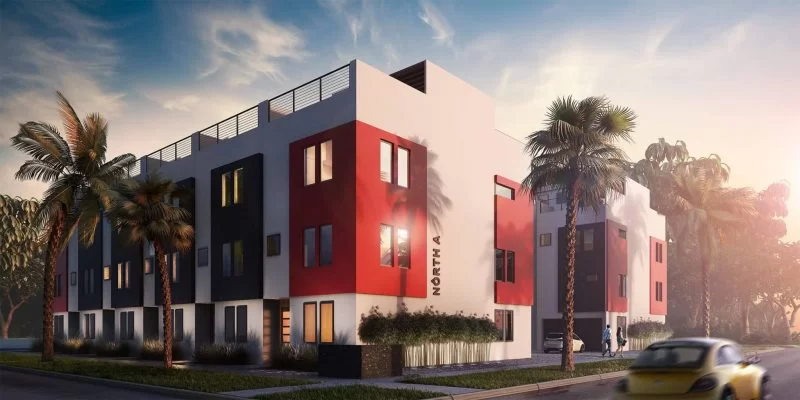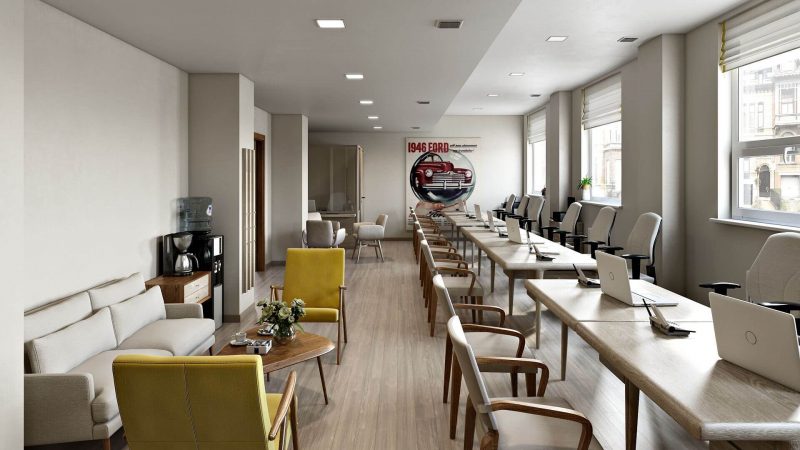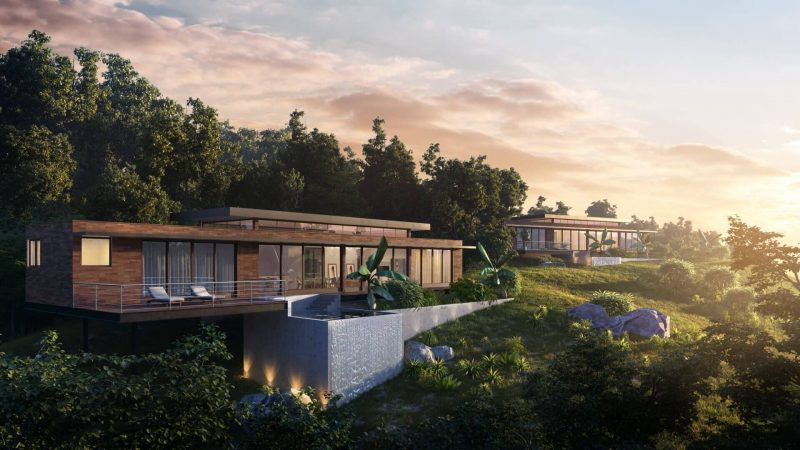Commercial building rendering is a true life-saver for architects. With a huge variety of angles, from bird’s-eye views to detailed close-ups, it allows them to fully showcase their designs in photorealistic quality. This way, 3D visualization gives the viewers a unique opportunity to see the building as if already complete and in operation.
But how can one use such CG images? Is there only one way to do that? Not at all! As an architectural visualization company, we know that 3D rendering helps architecture professionals at every stage of their projects and beyond. In this article, we want to share with you seven ways of using CGI to improve your practice and boost your career. Read on to find out!
#1. Empower Your Commercial Design Presentation

A presentation based on computer-generated images effectively conveys the value of the project. Look at the office building above – doesn’t it look amazing in the exterior 3D rendering for architects? The image reflects the feeling of modernity and simplicity, the balance of proportions in this geometry-based design. A viewer sees the color blocks painted vivid red perfectly harmonizing with white, the dominant tint. The building is a good place for a company to do business, and it reflects the company’s style perfectly. 3D rendering does what words cannot do: it leads to full understanding and stimulates the customer’s imagination.
#2. Take Part in a Competition and Win the Jury Over
Winning a high-profile architectural competition means a rapid advance in an architect’s career. For example, Jørn Utzon became world-famous in 1957, when his design for the Sydney Opera House beat other 232 projects. The building became a living embodiment of his mastery. All the world knows it as the main landmark of Sydney and one of Australia’s major tourist attractions.
In most competitions, the judges are short of time, and only a few scores of designs receive careful consideration. This way, a participant has to catch the jury’s attention and showcase as many advantages as possible to pass the preselection.
Architectural 3D rendering can amaze you instantly and make all benefits visible at first sight. Are you designing a luxury hotel for a competition? Commercial building visualization can demonstrate every detail working for the corporate identity while having its own individuality. Will the bar on the first floor captivate passers-by for an hour? A render will show it up.
If the project doesn’t win, it’s still a powerful card to play. Placed in the architect’s portfolio, it will attract new customers, and commercial 3D rendering will effectively demonstrate the architect’s expertise.
#3. Allow for Options with Commercial Business Rendering

It happens that a project needs several variants of design. For instance, a client insists on an idea that isn’t effective. In this case, the architect suggests two options: one meeting and one circumventing the requirement. Owing to commercial building rendering, the customer can compare both and choose the better one.
Sometimes, a request for tender provides for a specific number of options. So, the architect develops several variants of commercial design. As a rule, all options have a lot in common, and several parts can be copied from one render to another. This way, 3D interior design rendering services help reduce the overall cost.
Lastly, commercial 3D rendering comes in handy when tackling a design challenge. In such a case, various ideas may seem equally good, or none may be a good solution. Thus, only 3D visualization enables decision-making. For example, one can use restaurant rendering services to compare two fairy-tale theme dining hall designs. One meets the client’s expectations but goes far beyond the budget. The other is affordable but doesn’t satisfy the requirements. With renders of both, the client and the architect may come to a more balanced solution.
Ensure your exterior design project leaves a lasting impression and takes your clients’ breath away with stunning visuals.
#4. Use Exterior and Interior Rendering During Creation

Even if a commercial building design looks exceptional in drawings, it may need further improvements. Are the rooms of the newly drafted business center spacious enough for productive work? Will the staff get enough light in there? An office 3D rendering will help the architect review the design and guarantee that everything is impeccable.
#5. Get Precise Feedback with Commercial Building Rendering

Since photoreal commercial 3D rendering provides the exact view of the project, the customer can ensure it meets his needs. And if something is not to his or her liking, the client can speak it out during the architectural presentation. It’s much easier and cheaper to get a revision of CGI graphics than to change the course of construction on the go. Thus, 3D rendering helps avoid delays and unnecessary costs. By ensuring mutual understanding, it contributes to customer satisfaction.
#6. Suggest Commercial Renders to Client for Further Use

Providing commercial building renderings to customers adds even more value to an architectural project. A client can use them further to form a positive company image and promote its services on social media, emails, and commercials.
For instance, the hospitality 3D rendering above represents the business across several booking websites. The image radiates the peacefulness and calmness of an old cobbled street in the very heart of Mainz. More importantly, it conveys the coziness of the hotel that occupies a splendorous historic building.
Not only do clients use 3D visualizations for promotion, but architects leverage them, too. If brought together in a portfolio, CGI prominently represents his expertise in architecture and convinces the viewer to order architectural services. In SMM and email marketing, 3D renders draw the readers’ attention and persuasively showcase the service.
#7. Get the Builders Doing It Right with Commercial Building Rendering

Construction workers can read blueprints, but a visualization gives a better understanding of the result. A presentation underpinned by photoreal visualization and CGI handouts ensures that builders view the building the same way as the architect. For example, hotel room renderings like the above one deliver a holistic view of commercial interiors. A house painter and decorator who uses them will know the ultimate goal up to every minuscule detail. This way, construction becomes more predictable.
As commercial building visualization precisely conveys the architect’s vision, it contributes to clients’ certainty. They know for sure what they are going to get and renders provided to workers guarantee they will really get it.
Commercial building rendering helps the architect achieve his project goals in many ways. It makes for splendid, detailed presentations with breathtaking views the client won’t forget. Moreover, it comes in handy when communicating with builders or explaining to the client the best options available. And of course, commercial building rendering looks wonderful in an architectural firm portfolio, turning it into a lead-magnet.
Want to learn how much your project costs? See how we evaluate 3D rendering projects
Have a commercial project that needs an impeccable representation? Contactus and get photoreal CGI services that will help you reach new horizons!

Irma Prus
Content Writer, Copywriter
Irma writes articles and marketing copy for ArchiCGI. Her dream is that more people discover the power of CGI for architecture. Irma is into neuromarketing, ruby chocolate and Doctor Who series.





Comments
Eva Bernard